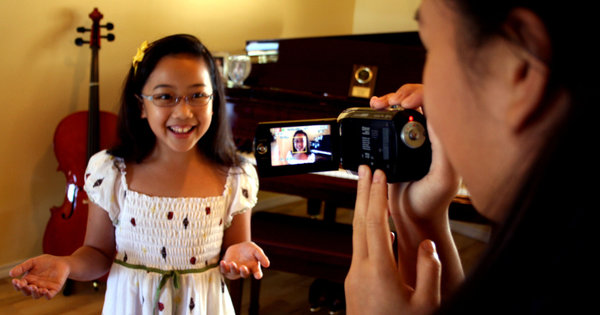|
Broadway Scouts Go Online
Posted on: 08/10/11
 Julia Tan, a 10-year-old actress who dreams of belting like Barbra, auditioned for her first Broadway show last month — 2,500 miles away, in her family room in Kuna, Idaho. As her older sister fumbled with a video camera and her mother beamed nearby as a cue (keep smiling!), Julia performed “Born to Entertain” from the musical “Ruthless!” for one of the three-minute audition tapes that little girls worldwide are sending in to the online casting call for the 2012 revival of “Annie.” “I did two takes,” Julia admitted by telephone, “but only because the camera cut off my head and then my feet the first time around.” A rite of passage for young actors — waiting in long lines to be seen by Broadway casting directors, clutching head shots with I-hope-I-get-it fervor — has faded, as more producers and directors have abandoned the long-held assumption that they need to be in the room to assess stage presence and other qualities. While some casting directors have looked at audition tapes here and there over the years, the advent of YouTube, Skype, Facebook, Flip cameras and widely available video equipment has recently given technology a greater role in theater casting, providing a foot in the stage door for the technically savvy. So far 320 young actresses have auditioned by video for “Annie” and 20 of them have been picked for in-person auditions by the casting director, Bernard Telsey, who has shepherded countless careers in the theater. (The online call for Annie and her fellow orphans is open through the fall.) While those numbers are smaller than the 1,250 girls who jammed the June open auditions in Manhattan and the 140 who received callbacks, Mr. Telsey said the taped auditions, which he collected with the aid of a specialist agency, ActorCast, were nevertheless a growing way for actors to become breakouts stars. Another major musical revival, of the Streisand vehicle “Funny Girl,” also held an online call this summer and received 308 videos from women in the United States, Britain, France, Israel, Vietnam and elsewhere, though the title role ended up going to the television and stage actress Lauren Ambrose, the producers announced last week. Such formal casting searches are still rare online compared with the hours that casting offices and some directors spend surfing the Internet nowadays for fresh faces. While no breakout theater star has been discovered solely through online auditions, several casting directors said it was only a matter of time. Mr. Telsey recently helped cast an inexperienced actor, Derek Klena, in the coming Off Broadway revival of the musical “Carrie” after Mr. Klena sent in a video for another job, as an understudy in “Catch Me if You Can.” The “Catch Me” creative team liked his tape, so he flew in from Los Angeles for a live audition; while he didn’t land the understudy part, the process led to a plum supporting role in “Carrie.” “Many talented and hardworking actors, people we want to cast, are increasingly shrewd about using technology to get in front of us,” Mr. Telsey said. YouTube, for instance, has become a go-to research tool on Broadway. A casting director for the hit musical “Billy Elliot” regularly hunts for talented children from their homemade videos on the site. The producers of the new musical “Sleepless in Seattle” added the songwriter Michelle Citrin to their creative team last year after seeing performance numbers that she posted to YouTube. And executives at Disney Theatrical Productions used YouTube to find and compile potential Ariels when “The Little Mermaid” was running. “I ended up collecting 20 possible Ariels on my YouTube ‘Mermaid’ account, and then Disney executives around the country were able to log on and assess each of them,” said Jen Rudin, a former casting director with Disney Theatricals. That search yielded Megan Campanile, a college student from Cincinnati who ended up on Broadway as an ensemble performer and Ariel understudy in “Mermaid.” For the musical revue “Sondheim on Sondheim” last year the director James Lapine constructed a montage of “Send in the Clowns” partially from clips he found while browsing for talent on YouTube and Facebook. Mr. Lapine, who is also directing the “Annie” revival, said that videos can sometimes help him notice talent that he might not otherwise see at live auditions. “Actors, especially young actors, can be very nervous when they’re performing live in front of us,” he said. “Video auditions can reveal a level of focus, concentration and confidence. But most of all videos can introduce you to skilled actors from all over the world who might not be able to get themselves to New York for an open call.” “Our business is now 40 percent Skype,” she said. “I was working with a client in North Carolina at midnight recently over Skype because that’s the time that worked best for her schedule and because she can’t get regularly to New York,” where the company is based. Over Skype Ms. Lettrich said she and her coaches can help develop breathing techniques, posture and muscle use for performers as they sing and act facing computer cameras. “The technology has reached such a point of sophistication that we can do the same work online that we could do in person,” she said. Homemade auditions only reveal so much, of course, and surely some of them obscure the guiding hand of stage mothers and fathers. Bartlett Sher, who is directing the “Funny Girl” revival, said that he appreciated the effort of the young women who sent in videos for lead role of Fanny Brice, but that he also wondered at times if he was watching canned performances or spontaneous talent from preternaturally gifted actresses. “You just don’t know how many takes the performers did to get their perfect audition tape,” Mr. Sher said. He ended up not calling in any actresses who submitted videos. Like Julia Tan, two other girls who created “Annie” videos, 11-year-old Caroline Ellis of Keller, Tex., near Fort Worth, and 10-year-old Kristen Dowling of Perkasie, Pa., said in telephone interviews that they did a couple of takes each. For the tapes girls were asked to perform a song (not “Tomorrow” or any other from the show) and to speak briefly on topics of their choice. Kristen said that while her parents had some ideas for the audition, like describing a beach trip, she opted to talk about something more personal: her affection for her dog, Linus. Caroline too showed some independence by trying to focus on the camera and her performances rather than family members who had gathered to watch. “I tried to remember that this audition was for professionals and not just making my family smile or sing along,” Caroline said. “But I’m glad my family was there. It’s nerve-racking to go into a strange room for an audition. If I had the choice, I’d always do it by video first.” Next time around, however, it will be in person: Caroline, Kristen and Julia are among the online talents who are being invited to Broadway for the next round of auditions. COMMENTS
Be the first to post a comment! Post A Comment:

|
.gif)



.jpg)

